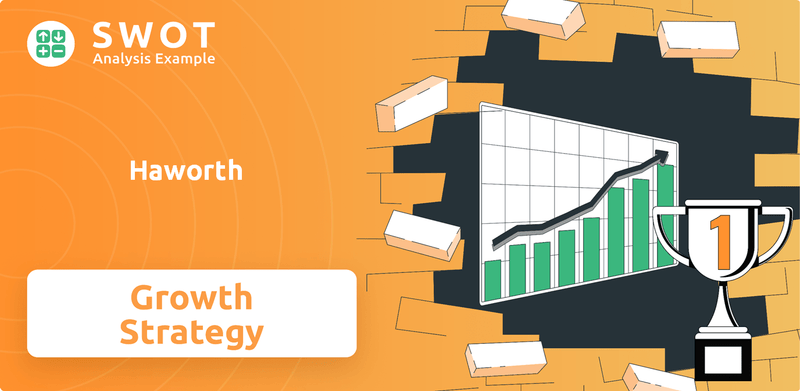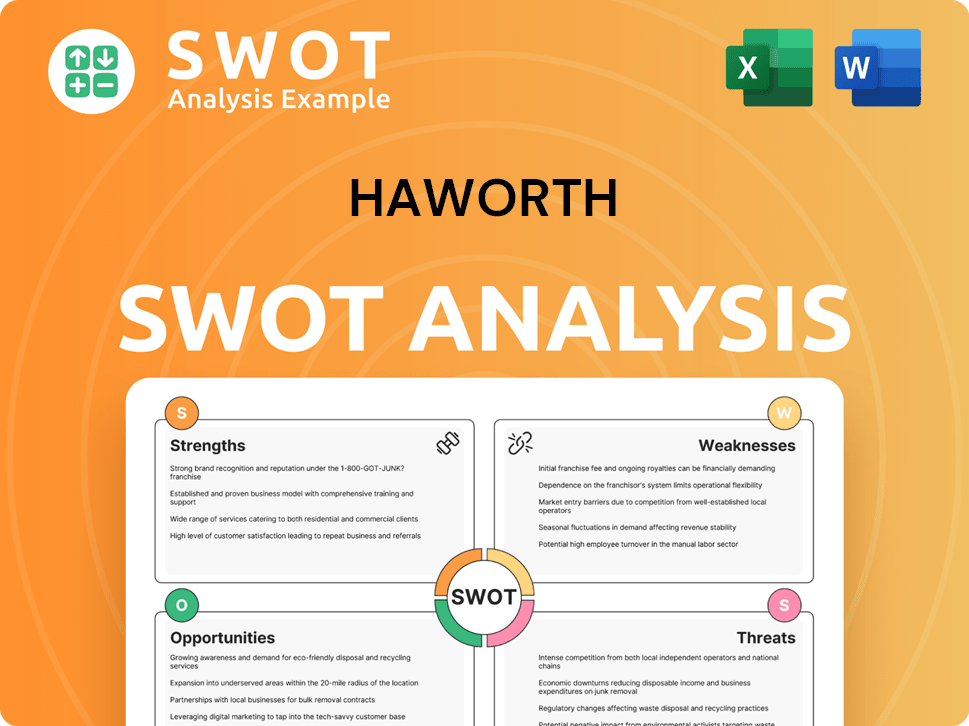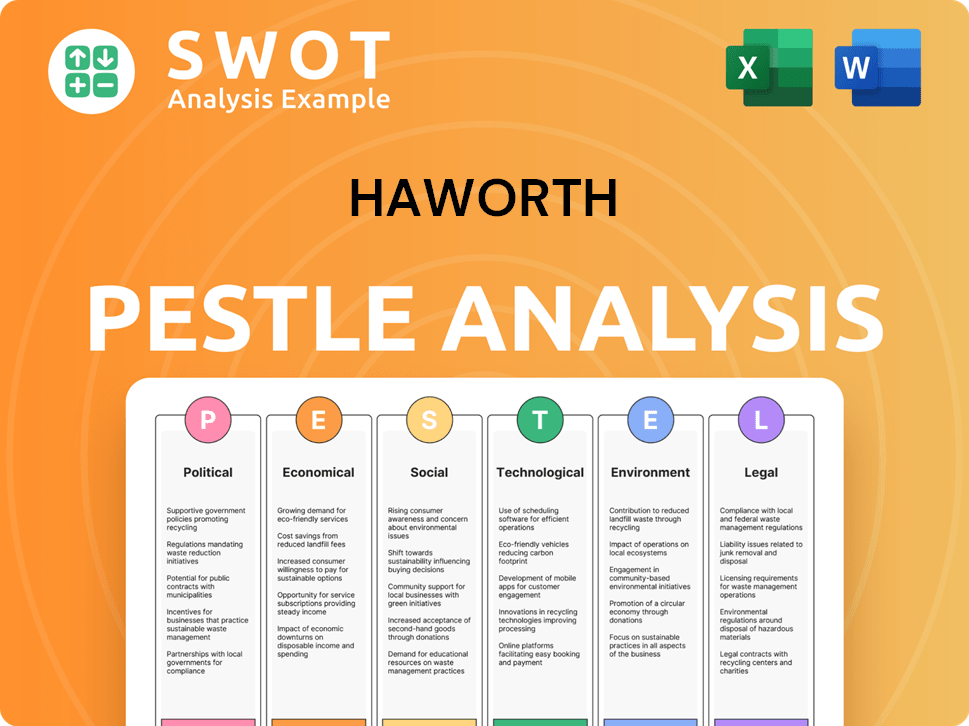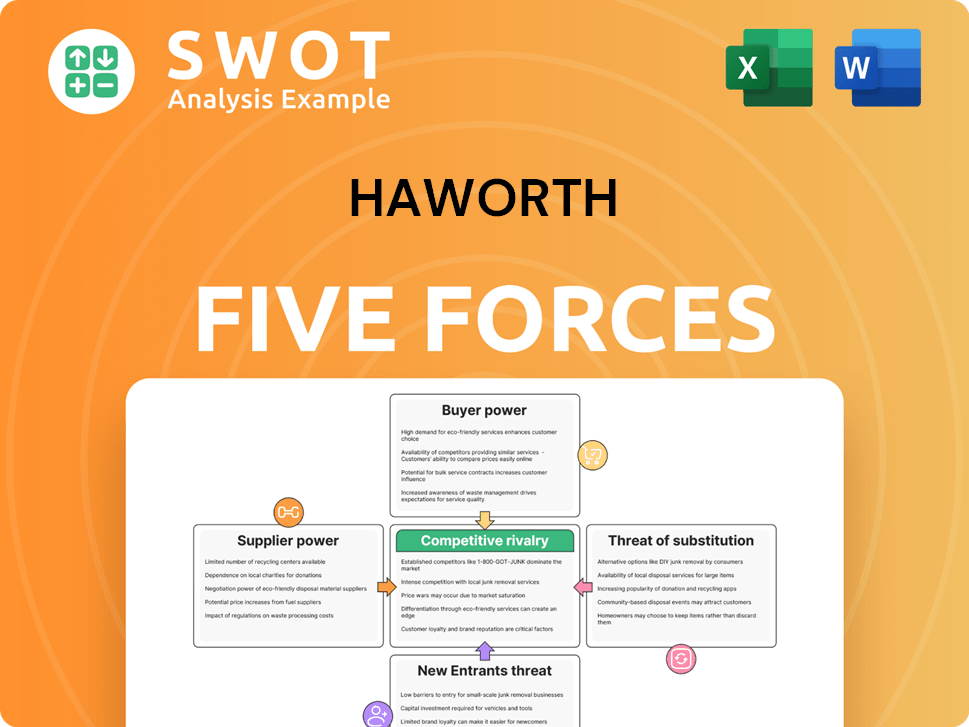Haworth Bundle
Can Haworth Redefine the Future of Workspaces?
Haworth's recent expansion, marked by a new factory in India, signals more than just growth; it's a strategic pivot towards global dominance in the evolving office furniture market. From a humble woodworking shop to a $2.5 billion global leader, the company's journey is a testament to its adaptability and forward-thinking approach to workplace design. This Haworth SWOT Analysis will explore how Haworth plans to navigate the complexities of the industry.

This comprehensive Haworth company analysis delves into the heart of Haworth's growth strategy, examining its ambitious expansion plans and innovative product strategies within the context of workplace design trends. We'll dissect Haworth's future prospects, considering its competitive advantages and how it addresses challenges and opportunities in the office furniture market. Furthermore, we will analyze Haworth's financial performance and sustainable business practices, offering insights into its long-term growth forecasts and impact on the office furniture industry, considering its global market presence and how it adapts to changing workplace needs.
How Is Haworth Expanding Its Reach?
The company is actively pursuing several expansion initiatives to strengthen its market presence and diversify its offerings. These initiatives are crucial for understanding the Haworth growth strategy and its Haworth future prospects. The company's approach includes both geographical and product-based expansions, aiming to capitalize on emerging opportunities in the office furniture market and adapt to evolving workplace design trends.
A key element of this strategy is the significant investment in expanding manufacturing capabilities. This expansion is a strategic move to optimize its supply chain and tap into new markets. The focus on both domestic and international markets highlights the company's commitment to sustainable growth and resilience.
These expansion efforts are designed to drive growth and enhance its competitive position. By strategically investing in new facilities, entering new markets, and expanding its product portfolio, the company is positioning itself for continued success in the dynamic office furniture industry. The company's strategic initiatives are vital for its long-term growth and market leadership.
The construction of a second factory in Chennai, India, represents a major expansion initiative. This project involves an investment of $8-10 million. The goal is to double the existing production capacity by the end of FY27. This expansion is a key part of the 'China+1' supply chain strategy.
The company is exploring new markets in Tier II cities across India. New showrooms are planned for Ahmedabad, Pune, Kochi, Indore, and Kolkata. This expansion aims to capture a larger share of the growing Indian market. These moves are part of the company's broader strategy to enhance its Haworth's global market presence.
The company has expanded its real estate footprint globally. Flagship showrooms have been opened, including one in New York City by Poltrona Frau. A new store in Zhuhai, China, was launched in 2024 by Cassina. These expansions support the company's international growth objectives.
The company continues to introduce new products and services. In 2024, new products such as the Haworth Breck office chair were launched. The company's circular services, including repair, refurbishment, reuse, recycling, and remanufacturing, are being rolled out globally. These initiatives are crucial for Haworth's sustainable business practices.
The company's strategic initiatives are designed to enhance its market presence and diversify its offerings. These efforts are critical for understanding the Haworth company analysis and its future trajectory. For more insights into the company's ownership and financial structure, consider reading Owners & Shareholders of Haworth.
A significant partnership was announced in October 2024 with MiEN. This collaboration focuses on expanding the presence in the education market. The partnership allows the company to offer a more comprehensive suite of products for educational spaces. The company's strategic partnerships are essential for adapting to changing workplace needs.
- Focus on the education market, particularly K-12 and higher education.
- Collaboration allows the company to offer a more comprehensive suite of products and solutions.
- The company's circular services are being rolled out to customers worldwide.
- These initiatives support Haworth's product innovation strategies.
Haworth SWOT Analysis
- Complete SWOT Breakdown
- Fully Customizable
- Editable in Excel & Word
- Professional Formatting
- Investor-Ready Format

How Does Haworth Invest in Innovation?
The Haworth growth strategy is deeply rooted in innovation and technology, aiming to drive sustained expansion within the office furniture market. This approach focuses on design excellence, digital transformation, and a strong commitment to sustainability. The company continually adapts to changing workplace needs, ensuring its products remain relevant and competitive.
The company's focus on innovation is evident in its product development and research and development (R&D) investments. This strategy is supported by a robust patent portfolio and a proactive approach to identifying and integrating emerging design trends. Further, Haworth's future prospects are significantly influenced by its ability to integrate sustainability into its core business practices.
The company's commitment to sustainability is reflected in its ambitious goals, including reducing emissions and adopting circular design principles. These initiatives, combined with a strong focus on digital transformation and customer needs, position the company for continued success in the office furniture market.
Haworth has a strong history of product innovation, exemplified by its early breakthroughs and ongoing R&D efforts. The company's innovative approach is reflected in its extensive patent portfolio, with over 400 patents. This focus allows it to stay ahead of workplace design trends.
Design excellence is a cornerstone of Haworth's strategy. The company collaborates with renowned designers and design studios to create innovative and ergonomic products. In 2024, the company received over 30 awards for its products, highlighting its leadership in design.
Digital transformation is a key component of Haworth's growth objectives. This includes implementing new ERP systems and optimizing its supply chain. The company also focuses on leveraging cutting-edge technologies and design trends to improve its operations and customer experience.
Sustainability is deeply integrated into Haworth's innovation strategy. The company aims to design all new products using circular design concepts by 2025. Haworth has committed to reducing Scope 1 and 2 emissions by 60% and Scope 3 emissions by 42% by 2030 (compared to 2021 levels).
Haworth's commitment to innovation has been recognized with numerous awards. The Pantaya Light won the Best of Year award in the Pendant Fixture category in December 2024. The 4SPACE fronts system was also an honoree in the Contract Partition + Wall System category.
Haworth proactively identifies and responds to market trends. In December 2023, the company released its '6 Emerging Surface Material Trends for 2024,' highlighting 'Hipstoric' as a key design trend. This proactive approach helps the company stay ahead in the competitive office furniture market.
Haworth's innovation and technology strategy is multifaceted, encompassing product development, digital transformation, and sustainability initiatives. These strategies are crucial for the company's continued growth and its ability to adapt to changing market dynamics. For more insights into the company's financial structure, consider reading Revenue Streams & Business Model of Haworth.
- Product Development: Focus on creating innovative and ergonomic products, exemplified by collaborations like the Fern® chair.
- Digital Transformation: Implementing new ERP systems and optimizing supply chains to improve efficiency.
- Sustainability: Designing new products using circular design concepts by 2025 and reducing emissions.
- Market Analysis: Proactively identifying and responding to emerging design trends.
Haworth PESTLE Analysis
- Covers All 6 PESTLE Categories
- No Research Needed – Save Hours of Work
- Built by Experts, Trusted by Consultants
- Instant Download, Ready to Use
- 100% Editable, Fully Customizable

What Is Haworth’s Growth Forecast?
The company's financial performance reflects a resilient global presence. In 2024, global sales reached $2.5 billion USD, mirroring the previous year's figures. This stability follows a 3% increase in 2023, reaching $2.57 billion USD, and a notable 16% growth since 2019. This performance highlights the company's ability to navigate economic uncertainties.
The company's President and CEO, Franco Bianchi, noted the resilience of both commercial and lifestyle sectors in 2024. This resilience, despite geopolitical and currency headwinds, positions the company well for future growth. The company's strategic approach focuses on maintaining a strong market presence while adapting to global economic shifts.
In India, the company anticipates significant growth. Haworth India Private Limited achieved a Total Operating Income (TOI) of ₹447.57 crore in FY24 (approximately $53.6 million USD) and ₹240 crore in H1FY25. The company's strategic focus on premium seating products and supply chain optimization has driven financial improvements.
Global sales reached $2.5 billion USD in 2024, maintaining the previous year's performance. This stability showcases the company's robust market position. This data is crucial for understanding the overall Haworth growth strategy.
Haworth India Private Limited recorded a TOI of ₹447.57 crore in FY24, equivalent to approximately $53.6 million USD. Double-digit growth is expected in 2024, indicating strong regional expansion. This expansion is key to understanding Haworth's future prospects.
The PBILDT margin for Haworth India nearly doubled from 7.44% in FY23 to 14.20% in FY24. This improvement is driven by strategic sourcing and a focus on premium products. This financial efficiency is a key aspect of the Haworth company analysis.
The company maintains a comfortable capital structure with an overall gearing of 0.21x as of March 31, 2024. Debt of ₹40.03 crore (approximately $4.8 million USD) was entirely related party borrowings. This stability is crucial for long-term growth.
The company's financial health is further supported by adequate liquidity, with unencumbered cash and bank balances of ₹36.63 crore (approximately $4.4 million USD) as of March 31, 2024. Ongoing investments in product introductions and global real estate are also part of the plan. The company is focused on enhancing customer experience and expanding in key markets.
The company aims to accelerate growth and reinforce industry leadership. This involves enhancing customer experience and expanding in key markets. The company's approach includes continuous innovation and strategic investments.
- Product Introductions: Ongoing investments in new product development are a key focus.
- Global Real Estate: Strategic investments in global real estate support expansion.
- Customer Experience: Enhancing customer experience is a priority for driving growth.
- Market Expansion: Focus on expanding in key markets to increase market share.
Haworth Business Model Canvas
- Complete 9-Block Business Model Canvas
- Effortlessly Communicate Your Business Strategy
- Investor-Ready BMC Format
- 100% Editable and Customizable
- Clear and Structured Layout

What Risks Could Slow Haworth’s Growth?
The path of Haworth's growth strategy and its future prospects is not without potential risks. The company navigates a complex landscape of competitors, supply chain vulnerabilities, and evolving technological and regulatory environments. Understanding these challenges is crucial for assessing the company's long-term sustainability and success in the office furniture market.
Haworth's ability to adapt to market dynamics, manage supply chain risks, and embrace innovation will be critical. This includes responding to workplace design trends and the changing needs of its customers. Assessing these risks helps provide a comprehensive Haworth company analysis.
The company's commitment to sustainability and proactive risk management are key elements of its strategy. This involves setting ambitious goals and investing in initiatives that align with environmental and social responsibility. Further insights can be found in an article about the Target Market of Haworth.
Haworth faces intense competition in the office furniture market. This includes large established players and numerous smaller firms, especially in developing markets. The presence of lower-cost products from unorganized segments poses a significant competitive threat, impacting Haworth's market share.
Reliance on group companies for pre-designed seating parts exposes Haworth to supply chain disruptions. Despite efforts to diversify, a significant portion of procurement still comes from specific entities. Geopolitical events or logistical issues could severely impact the company.
The design and manufacturing industry is subject to rapid technological advancements. Continuous investment in R&D and digital transformation is essential. Failure to innovate could lead to a loss of competitive edge in the office furniture market.
The cyclical nature of corporate office demand presents a risk. Economic slowdowns can moderate demand, impacting sales and profitability. The company must be prepared for fluctuating market conditions and adapt its strategies accordingly.
Changes in regulations, especially regarding sustainability, could necessitate significant investments. Haworth proactively addresses this by aligning with advanced sustainability reporting standards and committing to emissions reduction targets. Compliance is a key factor.
Talent acquisition and development can pose obstacles during expansion. Haworth mitigates this by fostering talent growth and promoting a culture of innovation. Addressing these constraints is crucial for sustainable growth and market presence.
Key competitors include large players like Steelcase and MillerKnoll, along with numerous local firms. These companies compete on price, product offerings, and market reach. Understanding the competitive landscape is crucial for Haworth's strategic planning.
Haworth employs a 'China+1' strategy to diversify its supply chain. Indigenous procurement is increasing, reaching up to 46% in FY24 in regions like India. Reducing reliance on any single source is a strategic priority for resilience.
Haworth is committed to ambitious sustainability goals, including zero waste to landfill by 2025. The company aims to reduce Scope 1 and 2 emissions by 60% by 2030. These efforts reflect a proactive approach to environmental responsibility.
Global economic slowdowns impacted demand in FY24, highlighting the cyclical nature of the industry. Haworth must adapt to changing workplace needs and market conditions. The company's adaptability is key to long-term success.
Haworth Porter's Five Forces Analysis
- Covers All 5 Competitive Forces in Detail
- Structured for Consultants, Students, and Founders
- 100% Editable in Microsoft Word & Excel
- Instant Digital Download – Use Immediately
- Compatible with Mac & PC – Fully Unlocked

Related Blogs
- What are Mission Vision & Core Values of Haworth Company?
- What is Competitive Landscape of Haworth Company?
- How Does Haworth Company Work?
- What is Sales and Marketing Strategy of Haworth Company?
- What is Brief History of Haworth Company?
- Who Owns Haworth Company?
- What is Customer Demographics and Target Market of Haworth Company?
Disclaimer
All information, articles, and product details provided on this website are for general informational and educational purposes only. We do not claim any ownership over, nor do we intend to infringe upon, any trademarks, copyrights, logos, brand names, or other intellectual property mentioned or depicted on this site. Such intellectual property remains the property of its respective owners, and any references here are made solely for identification or informational purposes, without implying any affiliation, endorsement, or partnership.
We make no representations or warranties, express or implied, regarding the accuracy, completeness, or suitability of any content or products presented. Nothing on this website should be construed as legal, tax, investment, financial, medical, or other professional advice. In addition, no part of this site—including articles or product references—constitutes a solicitation, recommendation, endorsement, advertisement, or offer to buy or sell any securities, franchises, or other financial instruments, particularly in jurisdictions where such activity would be unlawful.
All content is of a general nature and may not address the specific circumstances of any individual or entity. It is not a substitute for professional advice or services. Any actions you take based on the information provided here are strictly at your own risk. You accept full responsibility for any decisions or outcomes arising from your use of this website and agree to release us from any liability in connection with your use of, or reliance upon, the content or products found herein.